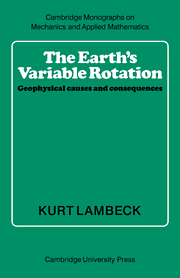Book contents
Preface
Published online by Cambridge University Press: 06 October 2009
Summary
The Earth's rotation has occupied the interest of astronomers, mathematicians and geophysicists for at least the last 200 yr. This continued involvement, in what must have initially been thought of as a straightforward problem, is a consequence of the multitude of factors that perturb the rotational motion from what it would be if the Earth were wholly rigid. Forces and deformations in the atmosphere, oceans, crust, mantle and core all perturb the rotation to varying degrees from the idealized rigid body motion, and a complete discussion requires one to delve into many aspects of the Earth and planetary sciences. It is undoubtedly this interdisciplinary aspect that has drawn astronomers, oceanographers, meteorologists and solid Earth physicists to the subject.
Geophysical studies of the Earth's rotation have their roots in the works of Lord Kelvin, Sir George Howard Darwin and Sir Harold Jeffreys amongst others. Munk & MacDonald, in 1960, thoroughly reviewed the subject in their monograph The Rotation of the Earth; a geophysical discussion. Their work has dominated the subject ever since and it is unusual to find any aspect of the problem that they have not touched upon. Yet since 1960, and probably because of their very considerable effort at clarifying the subject, much new information, both of an observational and of a geophysical nature, has become available. Some of this is collected in symposia proceedings, in particular those edited by Marsden & Cameron (1966) and by Mansinha, Smylie & Beck (1970).
- Type
- Chapter
- Information
- The Earth's Variable RotationGeophysical Causes and Consequences, pp. ix - xiiPublisher: Cambridge University PressPrint publication year: 1980

